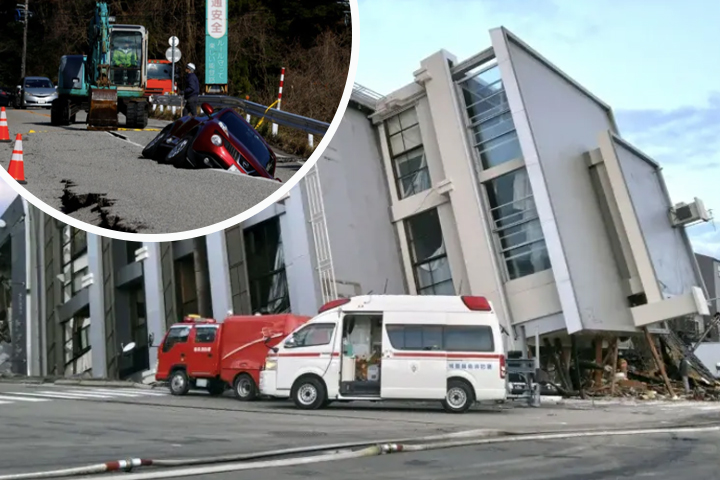


WAJIMA, Japan: Rescue crews struggled on Tuesday to reach remote places where buildings had been fallen, roads had been destroyed, and tens of thousands of houses had lost electricity following a strong earthquake that struck Japan on New Year's Day, leaving at least 48 dead.
The earthquake, which had a preliminary magnitude of 7.6, occurred on Monday afternoon. As tsunami waves smashed Japan's western shore, tossing vehicles and buildings into the ocean, residents in coastal districts were forced to evacuate for higher ground.
An army contingent of 3,000 soldiers, together with firemen and police officials, have been dispatched to the earthquake site in Ishikawa prefecture on the Noto peninsula.
Wearing a blue suit typical of officials during disaster relief efforts, Prime Minister Fumio Kishida declared during an emergency meeting on Tuesday that "the search and rescue of those impacted by the earthquake is a battle against time."
Rescuers were having a very hard time getting to the northern point of the Noto peninsula, according to Mr. Kishida, where helicopter assessments had shown extensive damage to houses and infrastructure, as well as several fires. According to his government spokeswoman, there are about 120 cases of persons who are in need of assistance.
There are no longer any planes or many rail services into the region. The airport in Noto closed owing to damage to the terminal building, fractures in the runway, and access road, leaving more than 500 passengers stranded.
Up to 1,000 homes may have been demolished in Suzu, a seaside hamlet of little over 5,000 residents close to the epicenter of the earthquake, according to its mayor, Masuhiro Izumiya.
“The situation is catastrophic,” he said.
This is Japan's worst earthquake since at least 2016, when a 7.3 magnitude one occurred in Kumamoto on the southern island of Japan, killing over 220 people, according to authorities, who have verified 48 deaths, all in Ishikawa prefecture.
Wajima, a city on the isolated northern extremity of the Noto peninsula, is home to many of the dead.
Authorities were fighting fires in many locations on Tuesday and rescuing people from collapsed structures, while many more people sustained injuries.
“I’ve never experienced a quake that powerful,” said Wajima resident Shoichi Kobayashi, 71, who was at home having a celebratory New Year’s meal with his wife and son when the quake struck, sending furniture flying across the dining room.
“Even the aftershocks made it difficult to stand up straight,” he said, adding his family were sleeping in their car because they could not return to their badly damaged home.
The Japan Meteorological Agency reported that since the earthquake struck on Monday, some 200 tremors have been recorded. The agency also issued a warning that additional powerful shocks may occur in the days ahead.
About 20 people were celebrating the new year at Fujiko Ueno's residence in Nanao city, Ishikawa, when the earthquake occurred, shattering the walls and causing them to collapse onto a parked car. Fujiko Ueno is 73 years old.
Everyone somehow came out unscathed.
“It all happened in the blink of an eye” she said, standing next to the crushed car on a road littered with debris and mud that oozed out from cracks in its surface.
A number of international leaders expressed their condolences to Japan, and President Joe Biden said in a statement that the US was prepared to assist it in any way that it might be needed.
About 100,000 individuals were forced by the Japanese government to leave their houses on Monday night. They were then placed in sports halls and school gymnasiums, which are frequently utilized as emergency shelters.
After the authorities canceled the tsunami warning on Tuesday, about half of individuals who had been evacuated had gone back to their homes.
However, according to Hokuriku Electric electricity's website, after a night when the temperature plummeted below freezing, almost 33,000 households in Ishikawa prefecture were still without electricity. Almost 20,000 residences lack access to water.
Following the catastrophe, the Imperial Household Agency announced on Tuesday that it would postpone Emperor Naruhito and Empress Masako's scheduled New Year's visit. Mr. Kishida canceled his Thursday, New Year's visit to the Ise Shrine.
On Tuesday, Japan's defense minister informed reporters that 1,000 army members are now participating in rescue operations, with the possibility of 10,000 deployments in the future.
The earthquake also occurs at a delicate moment for Japan's nuclear sector, which has been confronted with strong resistance from the community ever since the earthquake and tsunami that occurred in 2011 and caused nuclear meltdowns at Fukushima. That calamity claimed the lives of around 20,000 individuals and destroyed entire villages.
The largest nuclear power station in the world, Kashiwazaki-Kariwa, was placed under an operating prohibition by Japan last week. The plant has been shut down since the 2011 tsunami.
Nuclear plants in the Sea of Japan, including five operational reactors at Kansai Electric Power's Ohi and Takahama facilities in Fukui Prefecture, were judged to be normal, according to the Nuclear Regulation Authority.
The nearest plant to the epicenter, Hokuriku Electric's Shika facility, has likewise been idle since 2011. Following Monday's shock, the firm reported power outages and oil spills but no radiation releases.
The reactor's intended restart date was originally stated by the corporation as 2026.
In order to assess the impact of the earthquake on its facilities, Toshiba said that its local subsidiary, Kaga Toshiba Electronics, has ceased semiconductor manufacturing at its factory in Ishikawa.
Ahead of the scheduled return to business on Thursday, Kokusai Electric, a manufacturer of chip equipment, announced that damage had been discovered at its Toyama facility and that additional investigation was underway.